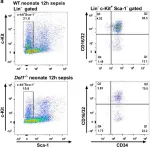Assessing the long-term efficacy of MPXV vaccine candidates is crucial for the global response to the ongoing mpox epidemic. Built upon our previous study of the mpox quadrivalent mRNA vaccine, herein we reported that MPXV-1103 could elicit sustained humoral and cellular immunity in mice, including the induction of MPXV A35/B6/A29/M1-specific IgG antibodies, VACV neutralizing antibodies and activated cytotoxic CD8+T cells, which provides 100% protection against lethal VACV challenge even at 280 days after the first vaccination. Our results provide critical insights for orthopoxvirus vaccine development.
Product Citations: 995
In Emerging Microbes Infections on 1 December 2025 by Li, E., Yang, Q., et al.
-
Genetics
-
Immunology and Microbiology
LAG3 limits regulatory T cell proliferation in α-synuclein gut-to-brain transmission model.
In Journal of Neuroinflammation on 5 July 2025 by Kong, W. X., Zhang, Z. L., et al.
Pathological α-synuclein (α-syn) can spread from the gut to the central nervous system (CNS), with CD4 + T cells playing a key role in this process. Lymphocyte activation gene 3 (LAG3) is involved in intestinal inflammation, regulates CD4 + T cell proliferation and function, and can specifically bind to pathological α-syn during cell-to-cell transmission. However, it remains unclear whether LAG3 is involved in the spread of pathological α-syn from the gut to the brain.
We utilized LAG3 knockout mice, combined with injection of α-syn preformed fibril (PFF) into the longitudinal and intermediate muscle layers of the pylorus and duodenum to model Parkinson's disease (PD). We used Immunohistochemistry staining, Western Blot, Flow cytometry to detect the changes of TH, α-syn, pro-inflammatory factors, barrier-related proteins and CD4 + T cells differentiation.
Our results show that LAG3 knockout partially alleviates psychological and behavioral deficits, dopamine system damage, and the gut-to-brain transmission of α-syn, which correlates with enhanced regulatory T cell (Treg) cell proliferation. Furthermore, LAG3 knockout improved intestinal dysfunction and increased the expression of tight junction proteins in both the gut and the blood-brain barrier (BBB). In CD4 + T cells isolated from the spleen, LAG3 knockout suppressed the aggregation of α-syn PFF, thereby inhibiting the toxic T-cell response induced by α-syn PFF. LAG3 deficiency also enhanced the IL-2/STAT5 signaling pathway, which regulates Treg proportions both in vivo and in vitro.
Our findings demonstrated that LAG3 intrinsically limits Treg cell proliferation and function in the environment with pathological α-syn and promotes the gut-to-brain transmission of α-syn.
© 2025. The Author(s).
-
Immunology and Microbiology
In Molecular Cancer on 3 July 2025 by Cui, Y., Qiu, T., et al.
-
Cancer Research
-
Immunology and Microbiology
In Nature Communications on 1 July 2025 by Li, J., Zhou, S., et al.
Biliary tract cancer (BTC) has a poor prognosis with limited treatment options. This phase 2 trial randomized 80 patients with unresectable/metastatic BTC 1:1 to sintilimab, anlotinib, and gemcitabine/cisplatin (SAGC) or chemotherapy alone (GC). At 13.4-month median follow-up, SAGC significantly improved median progression-free survival (8.5 vs. 6.3 months; HR 0.48, 95% CI 0.22-0.64, p = 0.005) and objective response rate (51.4% vs. 29.4%), with higher grade 3/4 adverse events (75.0% vs. 43.6%). Post hoc analysis showed enhanced efficacy with anlotinib 8 mg versus 10 mg (ORR 54.5% vs. 38.8%). In AKT/YAP tumor models, low-dose anlotinib (3 mg/kg) combined with sintilimab improved vascular perfusion, T-cell cytotoxicity, and cytokine secretion compared to high-dose (6 mg/kg). These findings demonstrate improved efficacy and manageable toxicity with SAGC, particularly at the 8 mg anlotinib dose, suggesting low-dose regimens may optimize antitumor response while mitigating adverse effects. Trial registration number ClinicalTrials.gov Identifier: NCT04300959.
© 2025. The Author(s).
-
Cancer Research
In NPJ Vaccines on 1 July 2025 by Sun, P., Pan, C., et al.
The antimicrobial-resistant (AMR) Klebsiella pneumoniae (Kp) poses an enormous threat to human health, with O2 serotypes accounting for up to 35-59% of infections. Although the O-polysaccharide (OPS) of the Kp O2 serotype can be used as an antigen target for vaccine preparation, its simple structure (only galactose repeats) makes it difficult to generate effective antibody responses and protection. Here, we prepared a novel Kp O2 OPS bioconjugate nanovaccine using protein glycan coupling technology (PGCT) and a SpyCatcher/SpyTag (SC/ST) orthogonal assembly system. The hepatitis B virus core antigen (HBc), which can assemble into nanoparticles, was used as a carrier to display OPS on its surface, allowing the bioconjugate to reach the nanoscale. The HBc-OPS exhibited attractive stability without aggregation or degradation for up to 10 months. A series of mouse experiments revealed the OPS-specific antibody activation ability of HBc-OPS and its protective effect against different infection doses. In particular, when coadministered with the AS03 adjuvant, all the mice were protected from higher doses of lethal attacks. Through in vitro and in vivo experiments, we found that the addition of AS03 further promoted the humoral immune response by stimulating increased levels of cytokines and T follicular helper (Tfh), germinal center B (GC B), and antigen-specific memory B cells. Moreover, we found that the use of AS03 as an adjuvant can provide a better protective effect than commonly used CpG-based adjuvants. Therefore, we have developed an attractive, stable, and effective bioconjugate nanovaccine against the Klebsiella pneumoniae O2 serotype. This bioconjugate nanovaccine design greatly potentiated the immunogenicity of polysaccharides, and the orthogonal modular assembly strategy reduced the technical difficulty of bioconjugate nanovaccine preparation, both of which could be applicable to the development of OPS conjugate vaccines for serotypes with low immunogenicity.
© 2025. The Author(s).
-
FC/FACS
-
Mus musculus (House mouse)
-
Immunology and Microbiology
In Nat Commun on 23 January 2024 by Vergadi, E., Kolliniati, O., et al.
Fig.8.A

-
FC/FACS
-
Mus musculus (House mouse)
Collected and cropped from Nat Commun by CiteAb, provided under a CC-BY license
Image 1 of 1
